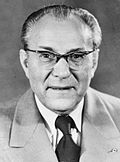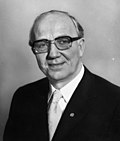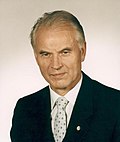Top Qs
Timeline
Chat
Perspective
Council of Ministers of East Germany
Highest executive and administrative organ of the People's Chamber From Wikipedia, the free encyclopedia
Remove ads
The Council of Ministers (German: Ministerrat der Deutschen Demokratischen Republik, pronounced [miˈnɪstɐˌʁaːt deːɐ ˌdɔʏtʃn̩ demoˌkʁaːtɪʃn̩ ʁepuˈbliːk]) was the executive and administrative organ of the supreme organ of state power, the People's Chamber. It existed from November 1950 until the country was reunified on 3 October 1990.[1] Originally formed as a body of 18 members, by 1989 the council consisted of 44 members.
This article needs additional citations for verification. (September 2014) |
Under the Constitution of East Germany, the Council of Ministers was formally defined as the government of East Germany. The same Constitution, however, officially confirmed the leading role of the Socialist Unity Party (SED). Hence, for most of the GDR's existence, the Council of Ministers was not the highest authority in the country, but was charged with implementing the SED's policies into practical administration. In particular, ministers were subordinate to the secretary of the Central Committee responsible for their portfolio, and, at least unofficially, to the General Secretary.
Remove ads
Structure
Summarize
Perspective

The Council was led by a chairman (Vorsitzender), who was usually called "prime minister" in non-German sources. There were two first deputy chairmen and nine other deputy chairmen. Together with some key ministers they formed the presidency (Präsidium) of the Council. The Präsidium prepared all decisions in consultation with the responsible departments of the Central Committee (Zentralkomitee) of the Socialist Unity Party of Germany (SED) and especially the Politbüro of the SED Central Committee. The Präsidium managed the day-to-day affairs of the Council between its weekly meetings, which took place regularly on Wednesdays to execute the resolutions of the Politbüro’s weekly meetings (on Tuesdays). The secretaries and department managers in the Central Committee were authorized to give instructions to the ministers as necessary.
Officially, the prime minister held the highest state post in the GDR. Despite this, no SED first secretary/general secretary ever simultaneously served as prime minister.

Until the Wende in the fall of 1989, the two first deputy chairmen were Werner Krolikowski and Alfred Neumann, who were both members of the SED Politbüro. Other deputy chairmen included the leaders of the four allied parties (Blockparteien). Additional members included the chairman of the State Planning Commission, the president of the Staatsbank der DDR (State Bank of the GDR) and some state secretaries, who were usually office directors at the Council. All members of the Council were selected by the GDR Volkskammer (parliament) for a term of five years. Within the centralized state structure of the GDR, the city, county and district administrations were subordinated to the Council.
Willi Stoph and his entire cabinet resigned on 7 November 1989. Stoph was succeeded by Hans Modrow. The SED gave up its monopoly of power on 1 December. Modrow continued in office, leading a cabinet with both SED/PDS and non-communist members.[1] For much of the winter of 1989 and 1990, he was the de facto leader of East Germany. Modrow was succeeded by Lothar de Maizière after what turned out to be the only free election ever held in East Germany, in March 1990. The de Maizière cabinet presided over the transition period to the reunification of the two Germanies in October 1990.
The former Prussian state parliament (Preußischer Landtag) served as the seat of the Council from 1950 to 1953. From 1961 to 1990 the Council's offices were located in the former Old City Hall of Berlin at No. 47 Klosterstraße. The Law Gazette of the GDR (Gesetzblatt der DDR) was also published by the Council. In addition, the Council’s Press Office made official government announcements and was responsible for the accreditation of foreign journalists in the GDR.
The individual ministries had their own headquarters buildings in East Berlin, although the former Reich Air Ministry building on Leipziger Straße housed the industrially-oriented ministries.
Remove ads
Chairmen of the Council of Ministers
Remove ads
Ministries
Summarize
Perspective
New Ministries from 1989/1990
Ministries of the armed forces
Industry ministries
In addition to the departments that are usual in every government, the Council of Ministers was characterized by a large number of industry ministries that were set up from 1950 onwards. The State Planning Commission was a central organ of the Council of Ministers ("Planning authority 1st level") to coordinate the work of the individual industry ministries ("Planning authority 2nd level"). 1958[5] the industrial ministries were dissolved and merged in 1961[5] in the newly founded People's Economic Council (VWR). The chairman of the VWR was Alfred Neumann (SED). These organizational changes occurred in the course of the introduction of the New Economic System of Planning and Management (NÖSPL). The VWR was abolished again in 1965 and individual industrial ministries were set up again. As before, these were subordinate to the State Planning Commission.
In 1972, the Ministry for the Glass and Ceramics Industry was formed from parts of the glass and fine ceramics industry of various other ministries. The next major change occurred in 1973, when the Ministry of Processing Machinery and Vehicle Construction was split into two ministries, the Ministry of General Machinery, Agricultural Machinery and Vehicle Construction and the Ministry of Tool and Processing Machine Construction.
In 1989, a far-reaching restructuring of the industry ministries took place: the ministries for Bezirk-managed industry and food industry and the glass and ceramics industry were dissolved, and the business areas were transferred to the Ministry of Light Industry on January 1, 1990. The ministries for mechanical and vehicle construction, tool and processing machine construction, heavy machinery and plant construction, and electrical engineering and electronics were transferred to a newly formed Ministry of Mechanical Engineering. Karl Grünheid (SED), previously the long-standing minister for the glass and ceramics industry, became minister. A Ministry of Heavy Industry was also newly formed, which was made up of the ministries for geology, ore mining, metallurgy and potash, chemical industry, and coal and energy. The new minister was Kurt Singhuber (SED), who had previously been the long-serving minister for ore mining, metallurgy and potash. The Ministry of Materials Management, however, was incorporated into the State Planning Commission.
In the de Maizière government the three remaining industrial ministries of light industry, heavy industry and mechanical engineering as well as the Economic Committee for the Implementation of Economic Reform, successor to the State Planning Commission, were incorporated into the Ministry of Economics, which had only been founded in 1989.
Commissions and offices equivalent to ministries
Other government offices of the Council of Ministers
In addition, independent state secretariats and central offices were directly subordinate to the Council of Ministers, including
- the State Secretariat for Labor and Wages: Hellmuth Geyer from 1965
- the State Secretariat for Church Affairs: Werner Eggerath, Hans Seigewasser, Klaus Gysi, Kurt Löffler
- the State Committee for Physical Culture and Sport
- the State Central Administration for Statistics (SZS): Arno Donda from 1963
- the Office for Standardization, Metrology and Product Testing (ASMW)
- the Office for Industrial Design (AiF): Martin Kelm from 1972
- the Office for Youth Affairs (including Johannes Keusch)
- the State Secretariat for Vocational Training (from 1970, previously from 1966 State Office for Vocational Training): Bodo Weidemann from 1968
- the State Office for Nuclear Safety and Radiation Protection (SAAS)
In some cases, their heads acted as members of the Council of Ministers.
Remove ads
See also
References
Wikiwand - on
Seamless Wikipedia browsing. On steroids.
Remove ads





